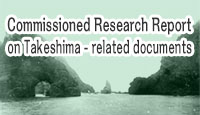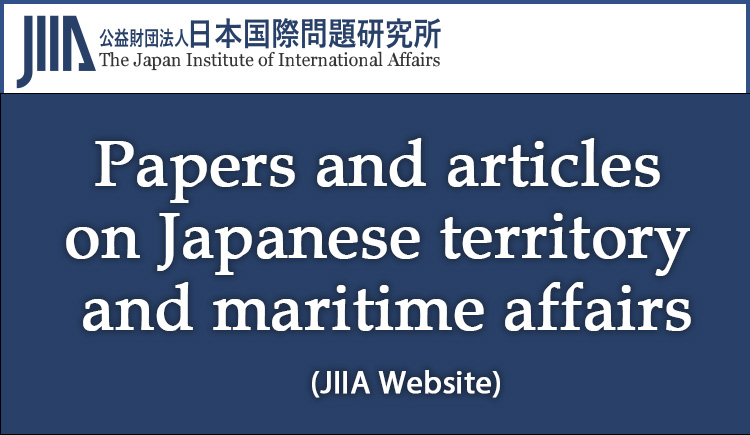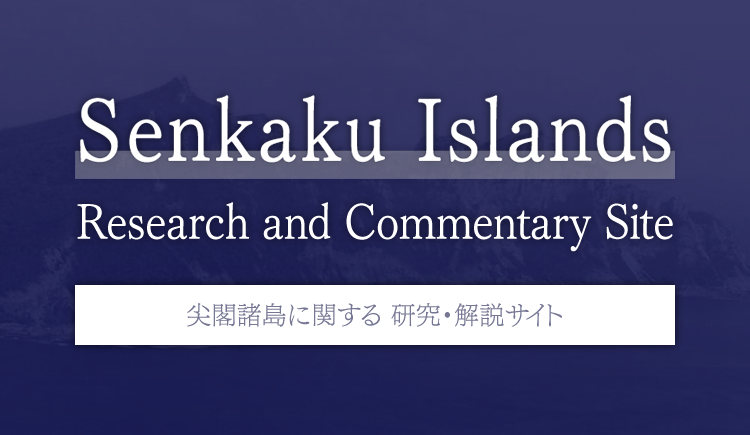The documents and materials published on this website were collected, researched, and prepared with advice from experts, as a part of a Government-commissioned project. The contents of this website do not reflect the views of the Government. Links to external sites (domains other than https://www.cas.go.jp) are not under the management of this site. For linked websites, please check with the organization/group that manages the website for the link in question.
Comprehensive issues
Column The Treatment of Takeshima in the Treaty of Peace with Japan
Takashi Tsukamoto (Former Professor at the Department of Law, Tokai University)
*Adobe Acrobat Reader DC, provided by Adobe, is needed to view the PDF files. If you do not have the software, please download it from the linked site. Adobe Acrobat Reader DC
Abstract
The range of Japan’s territory after World War II was determined by the Treaty of Peace with Japan (signed in San Francisco on September 8, 1951). The provision relating to Takeshima is Article 2 (a), which provides: “Japan, recognizing the independence of Korea, renounces all right, title and claim to Korea, including the islands of Quelpart, Port Hamilton and Dagelet.”
Some early drafts of the treaty placed Takeshima outside the range of Japan. However, the revised US–UK draft of June 1951 prescribed Article 2 (a) based on the understanding that Takeshima is Japanese territory. In July 1951, the Republic of Korea requested the US to amend that provision to state that Dokdo (the Korean name for Takeshima) is ROK territory, but in its response that August the US refused the ROK request to amend the provision, stating that Takeshima is Japanese territory. The provision in the revised US–UK draft became Article 2 (a) without any changes, and this determined that there was no change to Takeshima’s status as Japanese territory after the war.
Today, the ROK is claiming that SCAPIN (Supreme Commander for the Allied Powers Instruction Note) 677, which excludes Takeshima from the jurisdiction of the Japanese government under the Occupation, is based on the Cairo Declaration (which states that Japan will be expelled from areas it has taken) and that the San Francisco Peace Treaty is an extension of this policy. The ROK also insists that the above-mentioned August 1951 response from the US was only the opinion of the US and has no binding force to determine the territorial rights of Dokdo. However, Takeshima was never Korean territory, so the argument that it was “taken” does not hold. Furthermore, the above-mentioned drafting process, which includes the US response, has significance in interpreting the terms of the treaty (confirming the meaning of “Korea” in Article 2 (a)) as “the preparatory work of the treaty.”
1 Changes to Japanese Territory after World War II
With the end of World War II, Japan accepted the Potsdam Declaration (July 26, 1945). Paragraph 8 of the Potsdam Declaration reads: “The terms of the Cairo Declaration shall be carried out and Japanese sovereignty shall be limited to the islands of Honshu, Hokkaido, Kyushu, Shikoku and such minor islands as we determine.” The Cairo Declaration (announced December 1, 1943) prescribes, “It is their [US, UK and China] purpose that Japan shall be stripped of all the islands in the Pacific which she has seized or occupied since the beginning of the first World War in 1914, and that all the territories Japan has stolen from the Chinese, such as Manchuria, Formosa, and the Pescadores, shall be restored to the Republic of China. Japan will also be expelled from all other territories which she has taken by violence and greed. The aforesaid three great powers . . . are determined that in due course Korea shall become free and independent.”
Japanese carried out sea lion hunting and abalone fishing on Takeshima with permission from the government (the shogunate) in the 17th century, and Takeshima was incorporated into Shimane Prefecture through the procedures under modern international law in 1905: the island has never belonged to any country other than Japan. Accordingly, when determining the minor islands in paragraph 8 of the Potsdam Declaration, it was expected that Takeshima would be retained by Japan. The determination of which islands would be retained by Japan other than Honshu, Hokkaido, Kyushu and Shikoku, and which islands would be separated from Japan was made by the Treaty of Peace with Japan (signed in San Francisco on September 8, 1951, entered into effect on April 28, 1952). Article 2 (a) of the treaty—“Japan, recognizing the independence of Korea, renounces all right, title and claim to Korea, including the islands of Quelpart, Port Hamilton and Dagelet”—is the provision that relates to Takeshima.
2 Drafts by the US Department of State
The drafting of the Treaty of Peace with Japan began with the preparation of a draft of territorial clauses by the persons in charge at the US Department of State in March 1947,1 after the Treaty of Peace with Italy was signed. The Department of State drafts underwent numerous revisions thereafter; the main subsequent versions included the drafts of August 5, 1947, January 1948, October 13, 1949, November 2, 1949, and December 29, 19492. The Department of State drafts listed the islands retained by Japan, and individually stipulated the territories to be separated from Japan. Among these, the drafts through November 2, 1949 included Takeshima in the clause on territories to be renounced in favor of Korea3.
In response to the November 2 draft, William J. Sebald, the acting US political adviser for Japan, submitted commentary to the Department of State via telegram and detailed commentary stating that Japan’s claim to Takeshima “is old and appears valid.”4 This position was adopted, and in the December 29, 1949 draft, Takeshima was removed from the clause on territories to be renounced in favor of Korea (Article 6; see footnote 3), and added to the list of islands to be retained by Japan at the beginning of the territorial provisions (Article 3 Paragraph 1): “The territory of Japan shall comprise the four principal Japanese islands of Honshu, Kyushu, Shikoku and Hokkaido and all adjacent minor islands, including the islands of the Inland Sea (Seto Naikai); Tsushima, Takeshima (Liancourt Rocks), Oki Retto, Sado, Okujiri, Rebun, Riishiri. . . . All of the islands identified above, with a three-mile belt of territorial waters, shall belong to Japan.”
Note 1
US National Archives and Records Administration (NARA), State Department Records, RG59, Decimal File 1945-49, Box 3501, 740.0011PW (PEACE) /3-2047.
Note 2
1947.8.5 draft: NARA, RG59, 740.0011PW (PEACE) /8-647; 1948.1 draft: NARA, RG59, Lot56 D527, Records of the Office of Northeast Asian Affairs Relating to the Treaty of Peace with Japan, Box 4; 1949.10.13 draft: NARA, RG59, Decimal File 1945-49, Box 3503, 740.0011PW (PEACE) /10-1449; 1949.11.2 draft: NARA, RG59, 740.0011PW (PEACE) /11-749; 1949.12.29 draft: NARA, RG59, Lot54 D423, Japanese Peace Treaty Files of John Foster Dulles, Box 12, Treaty Drafts 1949-March 1951.
Note 3
Article 6 Paragraph 1 of the November 2, 1949 draft reads, “Japan hereby renounces in favor of Korea all rights and titles to the Korean mainland territory and all offshore Korean islands, including Quelpart (Saishu To), the Nan How group (San To, or Komun Do) which forms Port Hamilton (Tonaikai), Dagelet Island (Utsuryo To, or Matsu Shima), Liancourt Rocks (Takeshima), and all other islands and islets to which Japan has acquired title lying outside the line described in Article 3 and to the east of the meridian 124°15’ E. longitude, north of the parallel 33° N. latitude, and west of a line from the seaward terminus of the boundary approximately three nautical miles from the mouth of the Tumen River to a point in 37°30’ N. latitude, 132°40’ E. longitude.”
Note 4
Telegram: The Acting Political Adviser in Japan (Sebald) to the Secretary of State, Foreign Relations of the United States 1949, Vol.7, pp.898-900; Commentary: NARA, RG59, 740.0011PW (PEACE) /11-1949. In the detailed commentary, Sebald stated that the method of delineating the range of Japan by connecting points specified by longitude and latitude and fencing in Japan “has serious psychological disadvantages,” and he opposed this method.
3 Draft by Secretary of State Consultant Dulles
Next, “Daft #2”5 dated August 7, 1950 was prepared by John Foster Dulles, who was serving as a consultant to the Secretary of State. This and the subsequent drafts were much simpler compared with the previous drafts prepared by the Department of State, and did not have any provisions listing the islands belonging to Japan. The provision related to Korea in the August 7 draft reads, “4. Japan recognizes the independence of Korea and will base its relation with Korea on the resolutions adopted by the United Nations Assembly on December _, 1948.” This draft was revised on September 11, 1950,6 with its main points summarized in a seven-item memorandum of that same date7 The concerned section “3. Territory” simply states that “Japan would (a) recognize the independence of Korea; (b) agree to U.N. trusteeship, with the U.S. as administering authority, of the Ryukyu and Bonin Islands and (c) accept the future decision of the U.K., U.S.S.R., China and U.S. with reference to the status of Formosa, Pescadores, South Sakhalin and the Kuriles. . . .”
Because of the adoption of such simplified wording, there were no provisions listing the islands that belong to Japan and no mention of Takeshima, but there was no change to the understanding that Takeshima is Japanese territory. Responding to a question from the government of Australia, regarding the seven principles, for “more precise information concerning the disposition of former Japanese territories,” the Department of State replied, “It is thought that the islands of the Inland Sea, Oki Retto, Sado, Okujiri, Rebun, Riishiri, Tsushima, Takeshima . . . all long recognized as Japanese, would be retained by Japan. . . .”8
After the seven-point memorandum, the work of drafting the Treaty of Peace with Japan by the US government passed through the January 12, 1951 new memorandum (submitted by Dulles to the UK Ambassador) and the February 3, 1951 Dulles mission memorandum (unofficially presented to the Japanese government on February 5) to become the March 23, 1951 Provisional United States Draft of a Japanese Peace Treaty.9 The provision related to Korea in this US draft (Article 3) reads, “Japan renounces all rights, titles and claims to Korea, Formosa and the Pescadores. . . .”
Note 5
Foreign Relations of the United States 1950, Vol.6, p.1267-.
Note 6
Foreign Relations of the United States 1950, Vol.6, p.1297-.
Note 7
Foreign Relations of the United States 1950, Vol.6, pp.1296-1297; Department of State Bulletin, Dec. 4, 1950, p.881.
Note 8
Foreign Relations of the United States 1950, Vol.6, p.1328.
Note 9
Foreign Relations of the United States 1951, Vol.6, p.944-.
Takeshima
Research and Commentary Site
- I Comprehensive issues
- II Commentary on themes by historical period
- III Analysis of claims by other countries





